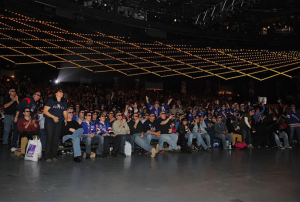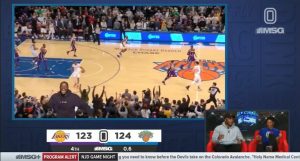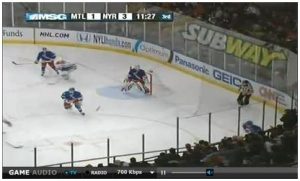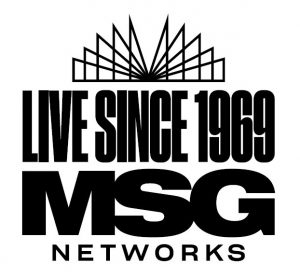Live Since ’69: MSG Networks Reflects on 50 Years of RSN Success
Linear content, digital series, refreshed logo get top billing in 2019
Story Highlights
1969 was chock-full of impactful events in American history, including, most notably, Apollo 11’s mission to the moon and the four-day-long Woodstock music festival. On Oct. 15 of that year, Manhattan Cable Television ushered in the first-ever regional sports network, covering a nighttime matchup between the New York Rangers and Minnesota North Stars. Fifty years later, MSG Networks continues to forge a legacy of debuting new technologies on live air.
“In 1969, we were the first RSN to launch and started with 125 events, including some Knicks and Ranger games,” says Jerry Passaro, SVP, network and technical operations, MSG Networks. “We continue to stay on the forefront of technology, and, as things make sense for us, we will evaluate and implement them.”
Yesterday’s Feats (1990-2009): Network Dips Toe Into HD, Virtual Signage
After nearly three decades in the linear space, the network began feeling the effects rippling through the industry near the turn of the 21st century. As concepts for viewing live games and shoulder programming in HD neared reality, MSG Networks was on the doorstep of its first major transition.
“Around 1998, the industry started to change. Before that, it was standard-definition television,” says Passaro. “It was the first big change, in a sense: MSG was one of the first regular providers of programming in HD. I was on the programming side at that point. Cablevision owned and managed MSG at the time. They were constantly pushing innovation, and HD was piloted by MSG and Cablevision together.”
Since MSG’s daring decision to transition to HD when it was still just a novelty, higher resolutions have become the norm.
“Once we embraced HD, there was no turning back,” says Passaro. “We built another HD truck when we switched vendors to Game Creek in 2009, another one in 2016, and we’re rolling out another 4K-capable, 1080p truck next year in 2020.”
Toward the end of the first decade of the new millennium, MSG enhanced its broadcasts again with an implementation that would propel the company deeper into the digital age. Deployed for sports coverage around the globe today, virtual signage on any of the hockey rink’s playing surface had never been seen on an RSN broadcast. In 2009, MSG saw that glass ceiling and exploded right through it.

Fans inside The Theater at Madison Square Garden on March 24, 2010, watched the Rangers defeat the New York Islanders in the first-ever NHL game in 3D.
“Basically, virtual signage was an opportunity to increase revenue opportunities,” says Passaro. “We had done some experimenting with PVI [Virtual Media Services] and rolled it out in the 2008-09 season with the whole sensor system. It was very labor-intensive. There were two operators, and there was a lot of setup time involved with that. In 2016, we changed the technology from the sensor system to the image-based system, so it’s a lot less labor-intensive.”
Digital World (2010-18): 3D, Fantasy Sports Intro New Era of Viewership
With the calendar flipping into the 2010s, digital-centric applications crept toward the center of the production universe. Making headway in movie theaters, 3D was a major technological trend reserved for the big screen. For an inner-city rivalry, though, on March 24, 2010, a selected number of Rangers fans watched their beloved Blue Shirts cruise to a 5-0 win in 3D for the first time.
“We basically [shot 3D] right to the home,” Passaro explains. “We also did a theatrical presentation at MSG and actually filled the entire theater. We had rented a full movie silver screen and had all kinds of officials and dignitaries from other leagues that were interested in it. It was viewed as a very positive type of event.”

MSG teamed up with Overtime for a social-media-heavy broadcast of Knicks vs. Cavs on March 17, 2019.
Like virtual signage, 3D has opened the door for other non-traditional viewing options, such as augmented reality (AR) and virtual reality (VR).
The past three years have been marked by huge strides in fan interaction and real-time data. A year before the advent of legalized sports betting, MSG Networks was the first to offer an alternative viewing option catering to fantasy sports, during a New York Knicks-Cleveland Cavaliers contest on Nov. 13, 2017. Even prior to the fantasy-infused showing, the company had waded into the waters of simulcasts.
“The prior season, in 2016-17, we did a test in hockey called The Power Play,” says Kevin Marotta, SVP, marketing and content strategy, MSG Networks. “We had the three hockey teams [Devils, Rangers, and Islanders] playing, and we showed every time each one was on a power play. We just kept going back and forth, and we said, Okay, there’s something interesting here.”
During this NFL Red Zone-esque experiment with multiple outlets, Marotta and the network honed their skills for what was to come with the primary game coverage on MSG and the secondary telecast on MSG+.
“We just went super deep for the daily fantasy audience and looked at that as an audience of people who are maybe fans of the sport but not necessarily fans of our team,” he says. “They were maybe more-casual fans that would come in specifically for that, so it was an opportunity to get a new audience. We also looked at it as an innovation that no one had done before.”
The positive results of the experiment paved the way for MSG’s most recent foray into interactive data: a partnership with Overtime that integrated live stats onto the MSG GO live-streaming platform during a New York Knicks-Los Angeles Lakers game on March 17.
“We asked ourselves, Are there other instances where we can look at a specific audience and do a simulcast that’s targeted at a specific group?,” says Marotta. “It was really sort of targeted and focused on Gen Z. On nights when we have only one team [playing], we really have an opportunity to do some interesting things and reach lots of people.”
Time To Celebrate: A Year-Long Plan Gets Under Way
Given all the pioneering that MSG Networks has done for the RSN business, the company is using this golden anniversary to reflect on its accomplishments while also focusing on future endeavors. In looking backward, the network’s broadcast and social-media teams have conjured up content for both linear and digital channels.
Last month, the television crew whipped up a graphics package commemorating the anniversary as well as player templates striking a nostalgic chord.
“[On television], we built an anniversary logo,” says Marotta, “and, for each of the games, we’re providing a lot of historical context around each of those teams and their time on our air. We’ve also sort of brought back some old opens and integrated new players with new content. It’s a mashup of old and new from a graphics standpoint.”
As for social media, MSG is going back to the vault and repurposing a ton of archival footage for multiple concepts.
“We’re rolling out a new digital series that highlights our greatest villains,” he says. “This is short-form content that’s going to live on our YouTube channel. [For example], we’re going to focus on Michael Jordan and his relationship with Madison Square Garden, Mark Messier from the point of view of a New Jersey Devils fan, and others [like Reggie Miller and his ’90s rivalry with the Knicks].
“We’re also doing something called Untold Stories, some things that people don’t know about our network or the history here,” he continues. “It could be anything from a boxer [who went on] to be a world champion but his first time on TV was when he fought as an amateur on MSG Networks. Or maybe some of these incredible point guards, [whose] first time they were on TV was when they were in high school in New York and the PSAL was on MSG Network. There are different things like that and different stories we’re going to dust off and tell in a new way.”
In a mix of linear and digital, on selected Thursdays, MSG is rerunning five classic games that played on its air, and its social staff is live-tweeting the action.
Leetch with the DIRTY dangle to put the Rangers up 1 #LiveSince1969 pic.twitter.com/uMxF4COWHa
— MSG Networks (@MSGNetworks) October 31, 2019
Tomorrow’s Ideas (2019 and Beyond): The Future of America’s First RSN
Maintaining a forward mindset, MSG pledges to continue its passion for ingenuity to honor the hard work of the past 50 years.
“Historically, we’ve strived to ignite the impassioned for the past 50 years,” notes Marotta. “That could come to life in different ways technologically. As we’ve gone out and talked to fans about how they pass on this sort of connection of watching these teams and [player] personalities that they love, we think that’s going to catapult us forward.”


